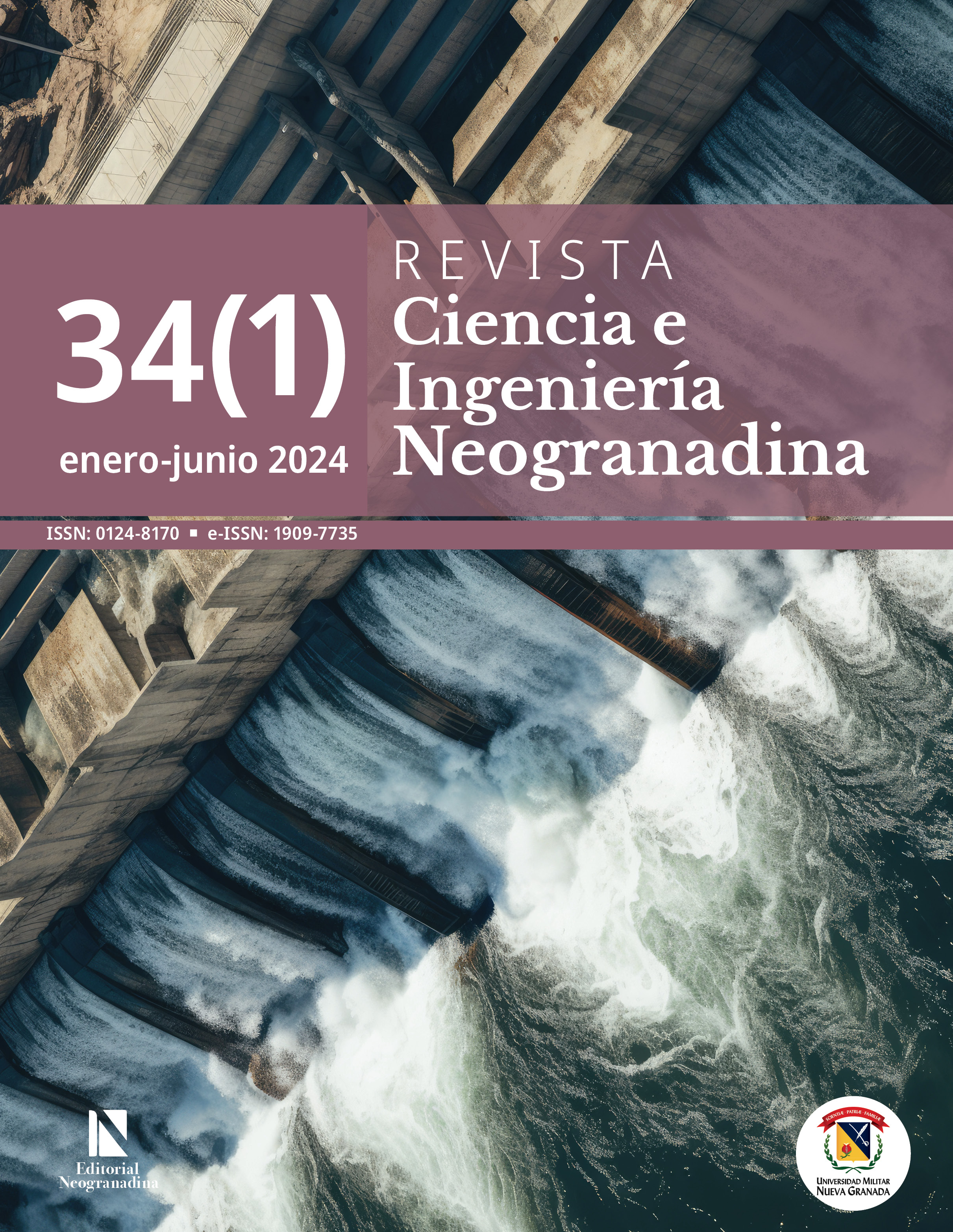Procesos de acorazamiento en un río tropical regulado, el caso del río La Miel
Resumen
En el presente estudio se analiza el proceso de acorazamiento (blindaje) que se presenta en el río La Miel (Colombia), un importante río tropical regulado y fuertemente modificado en sus regímenes hidrológicos, hidráulicos y sedimentológicos. Para confirmar la hipótesis del acorazamiento se emplean tres enfoques diferentes: 1) verificación cualitativa del proceso de acorazamiento realizada durante un recorrido de campo, 2) verificación cuantitativa del acorazamiento empleando el criterio definido por Little y Meyer (1976) para la desviación geométrica estándar de la granulometría del lecho (determinada con el software BASEGRAIN) y 3) análisis de los registros de carga de sedimentos en suspensión y de fondo en las estaciones de monitorio hidrosedimentológico. Los resultados indican que el río La Miel efectivamente se encuentra acorazado según la evidencia de campo y la marcada disminución en la carga de sedimentos de fondo, además, se identifica que el proceso de acorazamiento se ha dado en escalas de tiempo más cortas que las reportadas en la literatura para ríos extratropicales, debido al exceso de capacidad de transporte producido por el aumento sistemático de los caudales mínimos luego de la regulación y los transvases de los ríos Guarinó y Manso. Por otro lado, podemos indicar que efectivamente existe un umbral de caudal importante (234 m3/s) el cual se debe superar para que se rompa la coraza y se registre transporte de la carga de fondo.
Descargas
Referencias bibliográficas
E. D. Andrews y G. Parker, “Formation of a course surface layer as the response to gravel mobility”, in Sediment Transport in Gravel-Bed Rivers, pp. 269-325, 1987.
G. Parker, “Transport of Gravel and Sediment Mix- tures”, in Sedimentation Engineering, American So- ciety of Civil Engineers, pp. 165-251, 2008. https://doi:10.1061/9780784408148.ch03.
W. C. Little y G. P. Meyer, “Stability of Channel Beds by Armoring”, Journal of the Hydraulics Division, vol. 102, no. 11, pp. 1647-1661, Nov., 1976. https://doi:10.1061/JYCEAJ.0004651.
G. Parker y P. C. Klingeman, “On why gravel bed streams are paved”, Water Resour Res, vol. 18, no. 5, pp. 1409-1423, Oct., 1982. https://doi.org/10.1029/ WR018i005p01409.
G. Parker, C. P. Klingeman y G. D. McLean, “Bedload and Size Distribution in Paved Gravel-Bed Streams”, Journal of the Hydraulics Division, vol. 108, no. 4, pp. 544-571, Apr., 1982. https://doi.org/10.1061/JYCEAJ.0005854.
M. A. Hassan y M. Church, “Experiments on surface structure and partial sediment transport on a gravel bed”, Water Resour Res, vol. 36, no. 7, pp. 1885-1895, Jul., 2000. https://doi.org/10.1029/2000WR900055.
K. G. Heays, H. Friedrich y B. W. Melville, “Laboratory study of gravel-bed cluster formation and disintegra- tion”, Water Resour Res, vol. 50, no. 3, pp. 2227-2241, Mar., 2014. https://doi.org/10.1002/2013WR014208.
J. P. L. Johnson, “Clustering statistics, roughness feedbacks, and randomness in experimental step- pool morphodynamics,” Geophys Res Lett, vol. 44, no. 8, pp. 3653–3662, Apr. 2017. https://doi.org/10.1002/2016GL072246.
M. Church, M. A. Hassan y J. F. Wolcott, “Stabilizing self-organized structures in gravel-bed stream channels: Field and experimental observations”, Water Resour Res, vol. 34, no. 11, pp. 3169-3179, Nov., 1998. https://doi.org/10.1029/98WR00484.
L. Wittenberg, J. B. Laronne y M. D. Newson, “Bed clusters in humid perennial and Mediterranean ephemeral gravel-bed streams: The effect of clast size and bed material sorting”, J Hydrol (Amst), vol. 334, no. 3, pp. 312-318, 2007. https://doi.org/10.1016/j.jhydrol.2006.09.028.
R. R. Hendrick, L. L. Ely y A. N. Papanicolaou, “The role of hydrologic processes and geomorphology on the morphology and evolution of sediment clusters in gravel-bed rivers”, Geomorphology, vol. 114, no. 3, pp. 483-496, 2010. https://doi.org/10.1016/j.geomorph.2009.07.018.
M. G. Wolman, “A method of sampling coarse river-bed material”, Transactions, vol. 35, no. 6, pp. 951- 956, 1954.
A. Domínguez, “Procesamiento digital de imágenes”, Perfiles Educativos, vol. 72, p. 10, 1996.
P. E. Carbonneau, S. N. Lane y N. E. Bergeron, “Catchment-scale mapping of surface grain size in gravel bed rivers using airborne digital imagery”, Water Resour Res, vol. 40, no. 7, Jul., 2004, https://doi.org/10.1029/2003WR002759.
G. L. Heritage y D. J. Milan, “Terrestrial Laser Scanning of grain roughness in a gravel-bed river”, Geomorphology, vol. 113, no. 1, pp. 4-11, 2009, https://doi.org/10.1016/j.geomorph.2009.03.021.
D. Buscombe, D. M. Rubin y J. A. Warrick, “A universal approximation of grain size from images of noncohesive sediment”, J Geophys Res Earth Surf, vol. 115, no. F2, Jun., 2010. https://doi.org/10.1029/2009JF001477.
D. Vázquez-Tarrío, H. Piégay y R. Menéndez-Duarte, “Textural signatures of sediment supply in gravel-bed rivers: Revisiting the armour ratio”, Earth Sci Rev, vol. 207, p. 103211, 2020, https://doi.org/10.1016/j.earscirev.2020.103211.
L. Li, J. Xia, M. Zhou y S. Deng, “Riverbed armoring and sediment exchange process in a sand–gravel bed reach after the Three Gorges Project operation”, Acta Geophysica, vol. 68, no. 1, pp. 243-252, 2020, https://doi.org/10.1007/s11600-019-00391-2.
H. Fu, Y. Shan y C. Liu, “A model for predicting the grain size distribution of an armor layer under clear water scouring”, J Hydrol (Amst), vol. 623, p. 129842, 2023, https://doi.org/10.1016/j.jhydrol.2023.129842.
Q. Wang, L. Li, X. Li, Y. Wang y R. Nie, “Calculation Model to Predict the Static Armor Layer Size Distribution After the Reconstruction of a Gravel River Bed”, Front Earth Sci (Lausanne), vol. 9, 2021. https://doi.org/10.3389/feart.2021.660216.
S. Zhang, Z. Zhu, J. Peng, L. He y D. Chen, “Laboratory study on the evolution of gravel-bed surfa- ces in bed armoring processes”, J Hydrol (Amst), vol. 597, p. 125751, 2021. https://doi.org/10.1016/j.jhydrol.2020.125751.
C. Ikhsan, A. S. Permana y A. S. Negara, “Armor Layer Uniformity and Thickness in Stationary Conditions with Steady Uniform Flow”, Civil Engineering Journal, vol. 8, no. 6, pp. 1086-099, Jun., 2022, https://doi.org/10.28991/CEJ-2022-08-06-01.
C. Ikhsan, “The Effect of Shear Stress on Armor Layer Thickness Under Steady Uniform Flow”, Civil Engi- neering Journal, vol. 9, no. 11, pp. 2806-2822, Nov., 2023, https://doi.org/10.28991/CEJ-2023-09-11-012.
A. S. Negara, C. Ikhsan, RR. R. Hadiani y Hadima- ni. M. Purwana, “River Mobile Armor Layer Induced by Flood”, Civil Engineering Journal, vol. 9, no. 6, pp. 1356-1370, Jun., 2023. https://doi.org/10.28991/CEJ-2023-09-06-05.
M. Zhou, J. Xia, S. Deng, J. Lu y F. Lin, “Channel adjustments in a gravel-sand bed reach owing to upstream damming”, Glob Planet Change, vol. 170, pp. 213-220, 2018. https://doi.org/10.1016/j.gloplacha.2018.08.014.
D. Vázquez-Tarrío, M. Tal, E. Parrot y H. Piégay, “Can we incorrectly link armouring to damming? A need to promote hypothesis-driven rather than expert-based approaches in fluvial geomorphology”, Geomorphology, vol. 413, Sep., 2022. https://doi.org/10.1016/j.geomorph.2022.108364.
M. García y J. Maza, “Capítulo 8. Inicio de movimiento y acorazamiento”, in Manual de Ingeniería de Ríos, 1996.
Isagen, “Cartilla Central-Hidroeléctrica-Miel-I”, p. 4, 2018.
R. J. Batalla, C. M. Gómez y G. M. Kondolf, “Reservoir-induced hydrological changes in the Ebro River basin (NE Spain)”, J Hydrol (Amst), vol. 290, no. 1, pp. 117-136, 2004. https://doi.org/10.1016/j.jhydrol.2003.12.002.
G. Mathias Kondolf y R. J. Batalla, “Chapter 11 Hydrological effects of dams and water diversions on rivers of Mediterranean-climate regions: examples from California”, in Catchment Dynamics and River Processes, vol. 7, C. García y R. J. B. T. D. in E. S. P. Batalla, Ed., Elsevier, 2005, pp. 197-211. https://doi.org/10.1016/S0928-2025(05)80017-3.
L. Villablanca, R. J. Batalla, G. Piqué y A. Iroumé, “Hydrological effects of large dams in Chilean rivers”, J Hydrol Reg Stud, vol. 41, p. 101060, 2022. https://doi.org/10.1016/j.ejrh.2022.101060.
Gotta SAS, Aforos semestrales de monitoreo sobre los ríos La Miel y Guarinó, 2018.
M. Detert y V. Weitbrecht, “Automatic object detec- tion to analyze the geometry of gravel grains-a free stand-alone tool”, in River Flow, 2012, p. 6.
G. Parker y A. J. Sutherland, “Fluvial armor”, Journal of Hydraulic Research, vol. 28, no. 5, pp. 529-544, Sep., 1990. https://doi.org/10.1080/00221689009499044.

Derechos de autor 2024 Ciencia e Ingeniería Neogranadina

Esta obra está bajo una licencia internacional Creative Commons Atribución-NoComercial-SinDerivadas 4.0.











